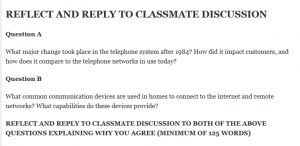REFLECT AND REPLY TO CLASSMATE DISCUSSION

Question A
What major change took place in the telephone system after 1984? How did it impact customers, and how does it compare to the telephone networks in use today?
Question B
What common communication devices are used in homes to connect to the internet and remote networks? What capabilities do these devices provide?
REFLECT AND REPLY TO CLASSMATE DISCUSSION TO BOTH OF THE ABOVE QUESTIONS EXPLAINING WHY YOU AGREE (MINIMUM OF 125 WORDS)
CLASSMATE’S DISCUSSION
Question A
In addition to the breakup of AT & T, another major change in the telephone system after 1984 is the Telecommunications ACT of 1996. This Act enabled anybody to offer local telephone services to homes and businesses; this included long-distance telephone companies, cable TV services operators, small companies, and electric companies (White, 2016p. 311). This maximized the capabilities of existing local telephones or cable lines which most homes and buildings were already wired with. It enabled homes or buildings to use their existing line to access both cable TV and phone services. This has led to internet cable modems we have in our homes today.
Question B
A great example of a common communication home device that connects to the internet is my Google Nest Wi-Fi MESH router. My google nest is equipped with three Wi-Fi access points that are systematically positioned throughout my house that ensures expanded coverage with robust connectivity. It supports all my internet capable home devices including all my TV’s, home security system, laptops, printer, and smartphones. Google also integrated the Nest user interface with their Google Home App. This enables me to remotely monitor network performance or troubleshoot using an app on my smartphone. This is a great feature because my wife is not tech savvy at all. When I am not home and the system goes down, I can troubleshoot my home Wi-Fi network remotely.
References:
White, C. (2016). Data Communications and Computer Networks: A Business User’s Approach (8th ed.). Independence, KY: Cengage Learnings.
REPLY 2
Question A
What major change took place in the telephone system after 1984? How did it impact customers, and how does it compare to the telephone networks in use today?
Question B
What common communication devices are used in homes to connect to the internet and remote networks? What capabilities do these devices provide?
REFLECT AND REPLY TO CLASSMATE DISCUSSION TO BOTH OF THE ABOVE QUESTIONS EXPLAINING WHY YOU AGREE (MINIMUM OF 125 WORDS)
CLASSMATE’S DISCUSSION
In 1984, the federal courts issued the Modified Final Judgment which caused the breakup of AT&T as the largest telecom provider in the US. This resulted in seven regional companies that competed for customers and resources within their region. Customers were given increased options for local telephony service as well as new options for long-distance service beyond their local telephone provider. However, over time those regional companies and many of their smaller competitors have merged or been purchased outright resulting in three primary competitors for land-line telephony services in the US today (White, 2014).
Today’s home communication systems cover a broad range of options. Standard landline or Plain Old Telephone System (POTS) phone connections still exist but are slowly being replaced by mobile phones or Voice over IP (VoIP) and digital telephony over Internet connections.
Digital Subscriber Lines (DSL) are still available in the US in connection with POTS phones, although are slowly being phased out in most non-rural areas. DSL provides internet connectivity over existing copper telephone networks. The connections are faster than dial-up internet but truly high-speed connections require high costs and often have limitations based on the distance from the customer location to the ISP’s network equipment.
Cable internet uses the same infrastructure as cable TV and often includes TV and telephone service on the same line. These connections operate at a much higher speed but can be negatively affected by congestion caused by a high number of subscribers in the area.
While not available in all markets, fiber to the premise is a relatively new option for Internet connectivity. In this solution, the Internet provider runs fiber optic cabling directly to the customer location for very high speed connections, again often bundling TV and/or telephone services on the same connection.